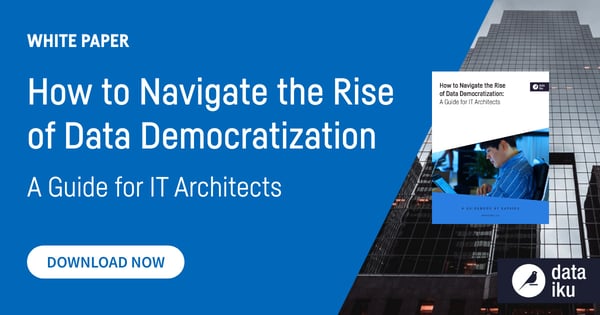In its simplest form, data democratization means that everyone has access to data and there are no gatekeepers preventing that access — everyone in the organization is equipped with ways (unique to their role) to understand data and leverage it to inform decisions and unearth new, value-added opportunities for the organization.
As organizations around the globe recognize this need for data ubiquity as a core element of any future-proof Enterprise AI strategy, teams are impacted in different ways in this race to scale data efforts. IT architects, specifically, are responsible for keeping the pace with this intensified demand for data, as well as making sure systems are functioning properly and security is maintained across the organization.
While data democratization undoubtedly causes more work for IT architects (as they now have to ensure the backend data plumbing works for everyone), their primary concern is actually data integration — receiving data from and pushing it to multiple sources, connecting sources together, and so on.
Therefore, while IT architects are not actually involved in data science projects, the onus falls on them to make sure the systems the data teams are using work, as well as to understand the business implications of these resources. In the next section, we’ll discuss how IT architects can use data science tools to make their jobs easier which, in turn, allows people to gather data themselves and merge it without IT intervention.
Orchestrating Data Efforts Across the Organization
Data orchestration involves automating the process of taking siloed data from multiple data storage systems and locations, combining it, and making it available for analysis and extraction (think: the simplicity of the final dashboards C-level executives may review before making a business decision).
Given the rising complexity of the data landscape, and data democratization as an organizational asset, having a sound handle on orchestration is pivotal for IT architects (and likely a function that will only continue to grow in importance). To mitigate the risks associated with data orchestration such as falling behind, becoming burdened with data processing and integration jobs, or making avoidable errors that come when dealing with tools that aren’t truly end to end, IT architects should leverage a holistic data science tool to:
- Enable a rapid understanding of who is using data, as its size and overall expense continues to ramp up across today’s enterprise
- Handle the proliferation of data and analytics, the demand for more data, and ease at which data-driven projects can be reused
- Offload data prep and ETL to the teams regularly using data, such as data scientists
- Support elasticity and resource optimization, allowing organizations to process massive amounts of data, large numbers of concurrent usage, and services deployed
- Enhance compliance and security through easy personal data identification, documentation, and data lineage, enabling compliance offers and auditors to do their job autonomously
The list above only scratches the surface of the benefits of performing data orchestration in one place, avoiding the need to glue different solutions or parts of the data pipeline together. Further, it solidifies the importance of the IT architect role in today’s enterprise, combining disparate datasets from different systems and locations together for insight extraction (and empowering other stakeholders to do the same).





